Calathea Yellow Leaves
Calathea is a genus of various beautiful flowering plants belonging to the Marantaceae family. Calatheas that are also known as prayer plants have colorful inflorescences in many species but for what they are valued for are their decorative leaves with numerous beautiful variegation patterns. But like various other plants with decorative leaves and foliage, calathea are also hunted down by harsh conditions that lead to Calathea Yellow Leaves.
Calathea species are native to the Tropical Americas, thus they prefer warm and humid climates. In genre, they are considered as indoor plants due to its easy to care for ability and decorative leaves that makes it a beautiful addition to indoor spaces. Moreover besides foliage, calathea species are adorned with various beautiful flowers making it an excellent choice in all aspects.
Although there are numerous beautiful flowers, still Calatheas are known for their beautiful and colorful foliage. The leaves are often large and variegated with bright colors such as pink, orange, red and white and the underside of the leaves are frequently purple. Another unique feature calatheas shows is the movement of their leaves. During the night the leaves fold up and in the morning they unfold in the search of morning sun. Undoubtedly that’s why they are named as prayer plants.
Chlorosis in Calathea Leaves
The term chlorosis is a term often used to describe the condition such as turning yellow and its literal meaning is loss of chlorophyll. The phenomenon of chlorosis in Calathea leaves is an alarming factor signaling towards plant damage due to various key factors such as watering issues, sunlight, especially nutrient deficiency or even alerting towards disease and pest attack.
For more information about Kitchen Garden you can visit: Companion Planting For Leeks
Other environmental factors that can cause turning yellow of leaves include temperature and humidity.
- Calathea are native to tropical rainforest climate and prefer warm and humid conditions.
- Suitable temperature ranges from 15-29℃. Extreme fluctuations from temperature ranges are harmful.
- Maintenance of high humidity is preferred otherwise the plant may wilt, eventually develop yellow leaves.
- In direct sunlight the plant tissues may burn.
These are environmental hazards for Calatheas . Other external factors such as fungi and disease attack may cause serious problems such as turning yellow leaves. But identifying the right cause of turning yellow of leaves can be more difficult as different factors form different types of turning yellow. This guide will help to identify and diagnose the cause of turning yellow.
Types of turning yellow
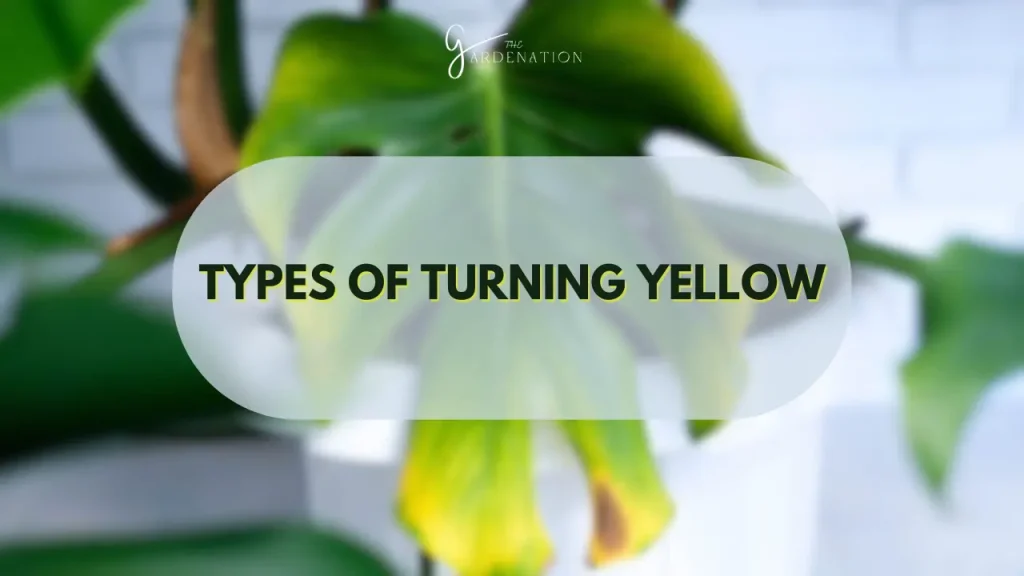
To rightly treat the plant one must know the right cause of turning yellow first otherwise without proper diagnosing we will pose more harm to our plant. Different symptoms help to diagnose the right cause of turning yellow as there is a different yellowing pattern formed by each pattern.
Following are a few patterns of yellowing due to different factors.
Color Variation
- Pale Yellow
This subtle turning yellow often starting between the veins is a factor hinting towards deficiency of nutrients such as Magnesium deficiency. Magnesium is a main nutrient in the structure of chlorophyll and its deficiency can ultimately lead towards chlorophyll imbalancement causing turning yellow of leaves.
Magnesium deficiency can occur when potassium-rich fertilizer is excessively applied. The uptake of excess potassium blocks the magnesium uptake thus this is how imbalance application of one nutrient affects the other.
- Yellow with a Tinge of Bronze
turning yellow with bronze contrast hints towards light stress. Calatheas are in general indoor plants. Like other various species of indoor plants they prefer bright indirect sunlight. But direct sunlight harshly affects the plant. The symptoms are necrosis with bronze color followed by turning yellow of leaves.
In this condition the texture of the leaf feels scorched with pale yellowness. It might result in stunted growth and loss of leaf. Describing how much intense sunlight can be harmful for these indoor varieties.
- turning yellow with Chlorotic Pattern
In this type of turning yellow the vein of leaves remains green and the surroundings turn yellow. This condition is also due to nutrient deficiency, mainly iron and nitrogen deficiency.
Nitrogen is a macronutrient that plays a vital role in chlorophyll production and also helps the transport of oxygen throughout the plant. It is identified as uniform turning yellow across the whole leaf.
Similarly iron is a micronutrient and its deficiency disrupts the production of chlorosis. Unlike nitrogen deficiency iron deficiency typically shows yellowing between the veins of leaves, while the veins themselves remain green. This is because iron is immobile in plants and can’t be easily transported from older to newer leaves. It is identified as turning yellow between the veins with green veins. If you want to know different varieties of Calathea: 10 Rare Calathea Varieties. Do Checkout!!
Progression of turning yellow
- Rapid turning yellow with yellow leaves
The rapid decline suggests a severe issue, such as root rot due to chronic overwatering leading to oxygen deprivation and fungal growth.
Overwatering is a serious factor when it comes to turning yellow leaves. The root zone becomes submerged and progresses towards root rot. It affects the ability of roots to uptake nutrients. Moreover the pores are blocked thus oxygen uptake is also affected resulting in the production of aerenchymatous cells that kill plant tissues.
Fungal Growth speeds up when favorable conditions such as proper moisture and temperature. This can be identified by leaf spots that are circular or irregular brown and yellow spots on the leaves. These spots eventually grow larger on the leaf surface. The leaves may turn yellow around the spots and eventually wilt or die
Certain fungi harshly affect and cause turning yellow in leaves.
- Cercospora- This fungus causes circular lesions on the leaves, sometimes surrounded by a yellow halo. The spots eventually grow larger covering the whole leaf area.
- Anthracnose- This fungal infection can cause similar lesions to Cercospora, but they may also appear sunken or scabby. In severe cases, the leaves may become distorted and drop prematurely.
- Turning Yellow Followed by Leaf Drop
turning yellow with leaf drop is indication that the plant is sacrificing its part to survive with limited resources. This suicidal condition may be due to stressors like under watering, over watering and light.
Underwatering- Underwatering is a condition when the plant has insufficient supply of water. So the plant reduces rate of transpiration, closes its stomata and instead of upward growth focus on root growth in order to find water. As a result possible abnormalities can be seen on plant leaves such as the appearance of crisp texture of leaves following turning yellow and wilting and eventually premature leaf drop. This leaf dropping is a survival mechanism of plants towards drought stress. To minimize the use of resources.
Overwatering- Where lack of water is harmful, excess of water is equally bad for plants. In this condition the plant undergoes anoxia to hypoxia state. Start killing its root cells to minimize water and oxygen uptake in order to survive. The symptoms of turning yellow with mushy texture appear on plants.
Light Stress- Indoor plants are susceptible to direct sunlight. Although they prefer indirect bright light. As described above direct light causes pale yellow color to cell death and scorched appearance of leaves leading to leaf drop.
- turning yellow with New Growth Remaining Green
This type of turning yellow is a sign of healthy growth, not any stress. It is a positive sign, where older leaves yellow and new growth remains healthy, suggesting the issue might be confined to older foliage and the plant is still putting out energy for new life.
In this case no extra measures should be taken. Just continue maintaining regular care and needs of plants. We have also discussed the causes of Olive Tree leaves turning yellow. You Must Checkout!!
Location of Leaves turning yellow
- Random Patches of turning yellow
This could indicate inconsistent waterings and light exposure. Calathea prefers uniform conditions, and uneven watering and light can cause random patches of turning yellow. These patches are randomly distributed or in the form of a distinct pattern or shape that helps to diagnose the problem.
- Yellowing Concentrated on one Side of the Plant
Light Stress- This type of turning yellow tells that the issue might be related to light. If the turning yellow is more prominent on the side facing away from the light source, the plant might be reaching for more light.
In this condition the side of the plant that is receiving the sunlight directly is relatively more affected than the other parts of the plant. The most easy and possible solution to get rid of this issue is to rotate the pot or just move the pot from that location to the place where it is not exposed to direct sunlight.
- Lower Leaves Turning Yellow with Brown Edges
Natural Aging- This is due to the natural aging process of the Calathea plant. Lower leaves often die back as the plant puts its energy into new growth upwards. This is an indication towards the healthy growth of plants. Thus, these yellow leaves can be removed by pruning for aesthetic purposes.
These are just a few examples and types of turning yellow of leaves due to various factors. If one is still concerned about the issue a picture of the plant should be taken and consulted with the specialist. However, by paying close attention to the details of turning yellow, one can provide the best care for calathea to keep its beautiful foliage healthy and thriving. Further I will explain the possible treatment against these stressors.
Prevention Against Turning Yellow of Leaves
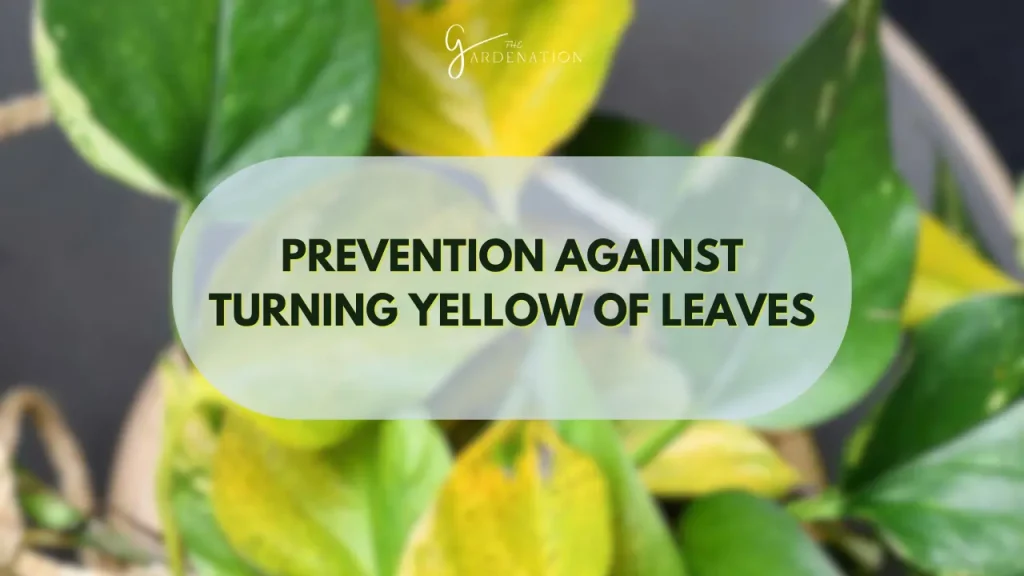
Calathea are versatile indoor species but they have very limited tolerance to external harsh conditions such as direct sunlight. They prefer warm and humid climates and extreme fluctuation such as extremely hot conditions and frost can affect their beauty. Otherly small pests and fungi like to feed on these plants causing the leaves to turn yellow.
Indeed there are several types and reasons for the turning yellow, few of them are explained below with the best treatment.
- Sunburn
- Low Humidity
- Poor Soil
- Improper Waterings
- Nutrient Deficiency
- Pest Infestation
- Fungal Attack
1. Sunburn
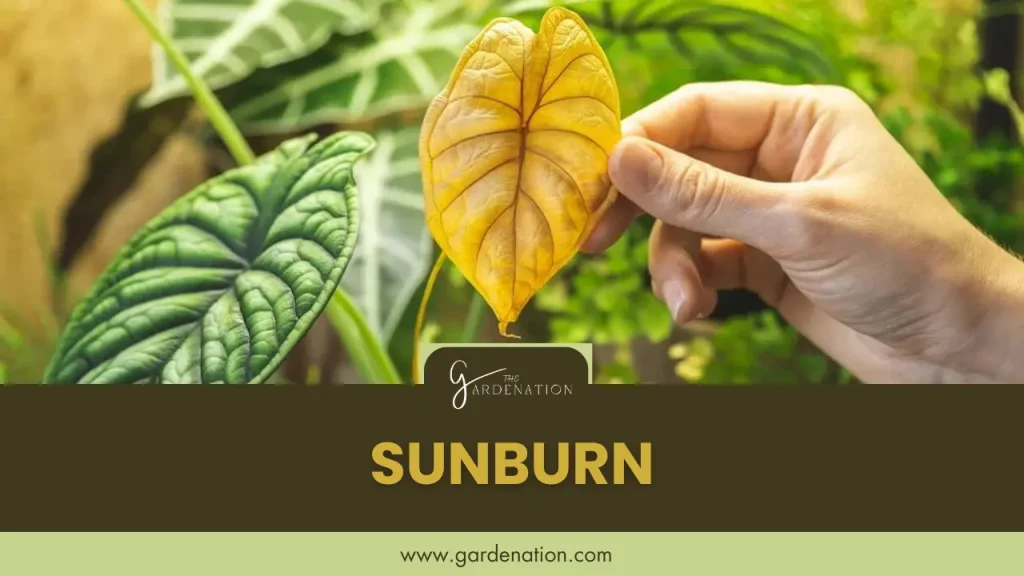
It is defined as a condition when the plant is exposed to too much sunlight. Too much high temperature with intense sunlight makes the environment unfavorable for plants and forms yellow patches on its surface eventually leading to leaf drop.
Treatment
- Sunburn is a serious concern in calathea plants. So they must be kept away from direct sunlight and windows.
- Choose a place with shade for calathea plants even indoors, otherwise it may lose its color too.
- The sunburnt leaves are not meant to be pruned immediately as they provide protection with their shade to the underlying leaves.
- These plants are best to use on tables and niches where sunlight doesn’t reach.
2. Improper Waterings
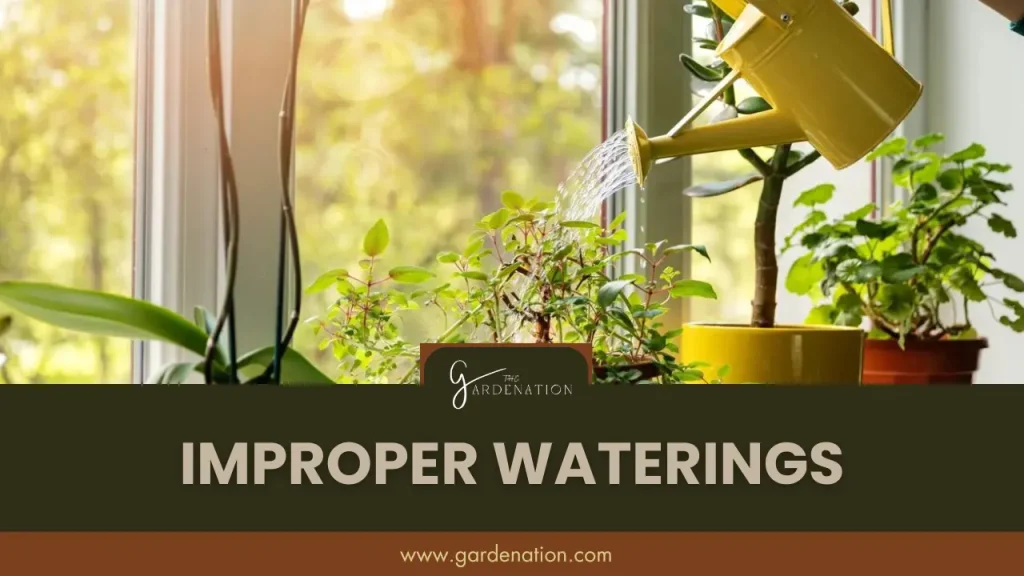
Calathea are affected badly both by overwatering and underwatering
Underwatering is a condition that occurs when the calathea plant doesn’t receive enough water to maintain its health and function. This condition can be due to infrequent watering or extremely hot and dry weather.
Overwatering occurs when too much water is applied to the plant. Symptoms of overwatering may involve soggy soil, brown spots on leaves that started as yellow patches. Leaves become soft and yellow and eventually drop. Root rot and fungal diseases may also occur due to overwatering.
Treatment for Under-watering and Overwatering
- To prevent drought or underwatering, water calathea plants deeply, allowing water to drain completely.
- For pots use sandy loam and silt loam soils that are well drained.
- To prevent overwatering, always let the top soil dry out before watering.
- Always make sure the drainage holes are open.
- Pruning of rotten roots is also necessary to be done carefully, for proper water intake by the roots and to prevent accumulation of excess water.
- A proper schedule of watering and soil checking must be made and maintained.
3. Low Humidity
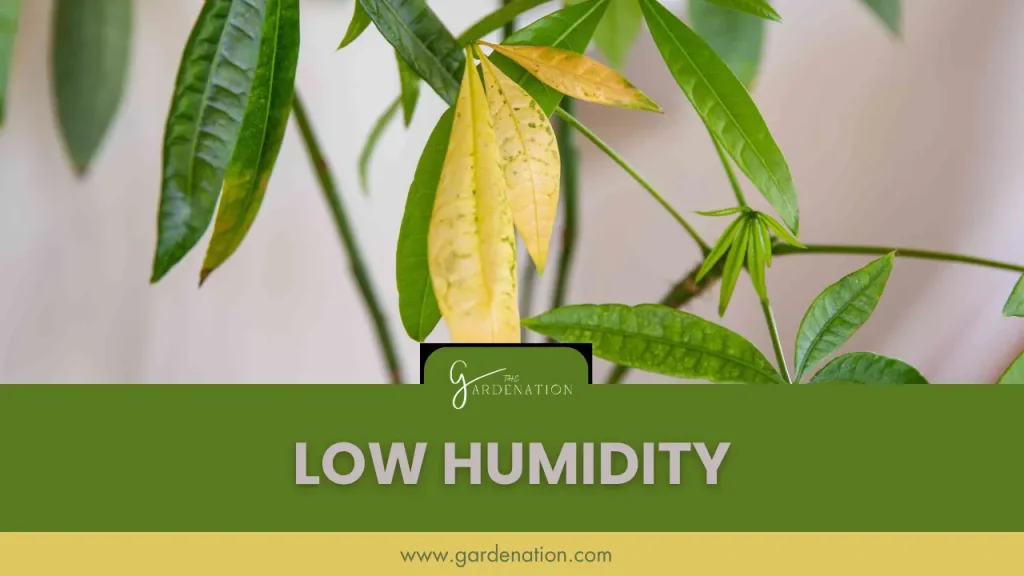
Calathea plants are native to tropical rainforest regions where humidity is high. So they prefer a high humidity (40-60%) for their surroundings. Like other plants for them, atmospheric water (water in air) is as important as water in soil. Dry environment can badly affect the plant causing the plant leaves to transpire water at faster rate and lead to dehydration, wilting even if there is sufficient water in soil.
In this condition the edges of leaves first dry out turning into crisp brown color. Low humidity slows down the growth and development of plants. Pests who prefer low humidity like spider mites can also affect the calathea plant.
Treatment
- The most preferable solution to this problem is the use of humidifiers to maintain humidity.
- If humidifiers are not easily available, use a water sprayer to produce a mist-like environment around the plant regularly. But this shouldn’t be done in direct sunlight.
- Placing plants close to each other also favors humidity to each other by transpiration process.
- Place the pot on a tray with pebbles and water. When the water evaporated it increased humidity around the plant. Note that humidity above 80% is also harmful.
4. Nutrient Deficiency and Toxicity
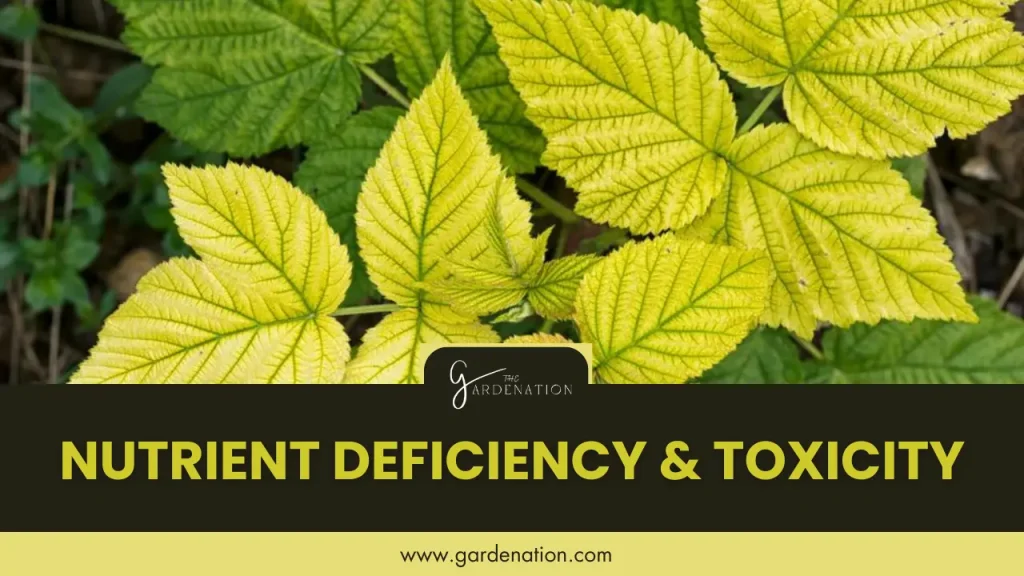
Deficiency is defined as lack of nutrient supply and toxicity is defined as excessive supply of nutrients. There are various nutrients in plants, each nutrient has its role in growth. Similarly each nutrient has its own deficiency and toxicity symptoms. So nutrient deficiency and toxicity is a major concern in improper plant growth.
Imbalancement of Magnesium, Nitrogen, Iron and Potassium minerals can cause turning yellow of Calathea leaves.
Treatment
- Application of mineral nutrients and fertilizers containing required minerals is the best and possible treatment of mineral deficiency. As it is essentiality criteria of the minerals that they can’t be replaced by any other constituents.
5. Poor Soil

Poor soil conditions are equally harmful for plants as other factors. Such as acidic soil and saline soil. In case of low pH of soil the nutrients become unavailable even if they are given in case of fertilizers, plants will not be able to uptake them. So even in the case of nutrient rich soil. Soil low pH causes nutrient deficiency in leaves.
The lack of nutrients due to low pH results in similar effects as nutrient deficiency yellow leaves at leaves margins and turning yellow following the interveinal cirrhosis leading to necrosis.
Another poor soil condition is salinity, it occurs when the soil EC is above desired EC level (4dS/m). It can be due to filling the pot with any soil without analyzing it or due to irregular use of fertilizers without any considerations.
The issue of salinity produces drought-like conditions for plants. But the concern is water is applied, still the plant refuses to take water. It is due to osmotic imbalancement. The concentration of salt is higher in soil than plant, which will create a hypertonic environment so instead of water entering the roots the roots will release their water.
As a result of salinity the edges of roots and tips of leaves will turn yellow. The plant experiences slow growth and in severe cases leaf drop may occur. The leaves may develop a crisp texture due to lack of water.
Treatment
- Use of gypsum and other basic minerals to rise pH of soil to desired level.
- Use distilled water if possible to maintain salinity in saline soils.
- Leach down the excessive salt, by flushing the soil with excess water.
- Use fertilizer with proper guidance and consideration
- As we are using soil for pots, it’s better to replace soil with fertile soil with adequate pH and EC level.
6. Pest Attack

Pest infestation is another cause of turning yellow of leaves of calathea. There are different pests such as scales, mites and thrips that are the major cause of leaves turning yellow in calathea and other indoor plants.
Mites- Spider mites and other mites are small sap sucking insects. They suck sap from leaves and leave behind spots of discoloration including yellow leaves leading to brown spots. They can be identified by webs on leaves.
Thrips- Thrips is another sap sucking insects affecting both leaves and fruits. They create silvery-brown scarring on leaves and also contribute to yellow leaves.
Treatment
- Use of neem oil as natural insecticide helps to reduce these pests.
- They can be identified and removed from leaves manually.
- Chemical control can be taken if necessary but it is not eco-friendly and can produce foul smell in the house .
- In case of severe pest infestation remove the most affected parts to prevent other parts from being infected.
7. Fungal Attack
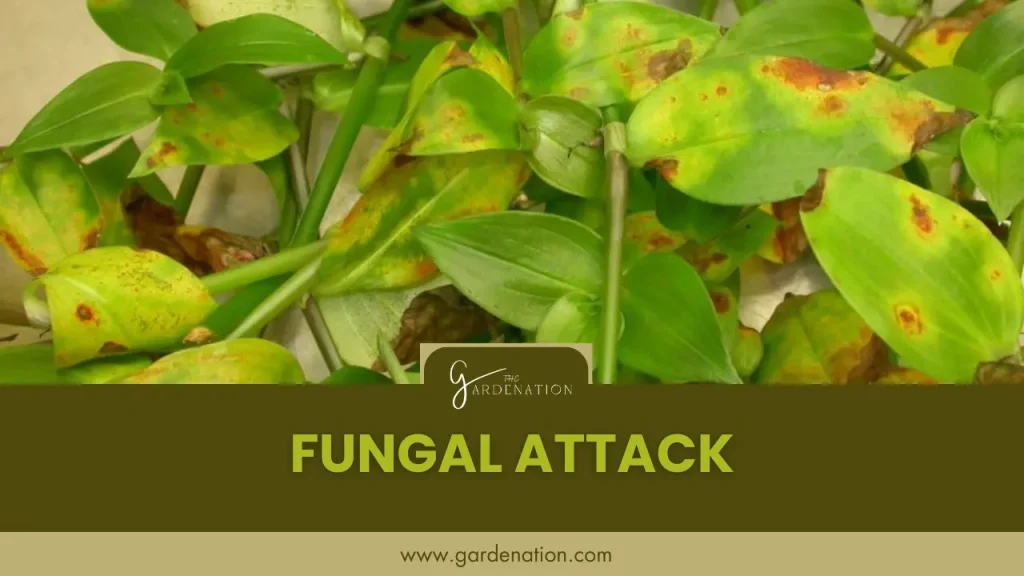
Several fungal diseases can cause yellow leaves on calathea leaves. The most common of them are;
- Rhizoctonia Root Rot- This fungus attacks the root zone, leading to stunted growth and yellow leaves with brown spots on leaves with soaked appearance. It occurs due to soggy and over watered conditions.
- Cercospora Myrothecium- It causes Leaf Spot Diseases in calathea with the appearance of yellow leaves. It spreads with moisture on the leaves.
Treatment
- Separate the infected pots to prevent disease spread in other pots.
- Cut off any infected part to prevent other parts of plants.
- Increasing airflow also aids in fungal prevention. As fungi find moisture and when we dry the soil, the fungi might die.
- In case of root rot, it is recommended to replace the pot.
- Apply broad spectrum copper based fungicide to chemically treat fungal infections.
These are the several reasons for the turning yellow on leaves of calathea plants. Here I have also mentioned the possible symptoms and treatment. So after diagnosing the cause with proper care we can revive the health of our calathea plants.
Frequently Asked Questions About Calathea Yellow Leaves
Are Calatheas Evergreen or Deciduous?
Calathea are flowering plants. But they are known for their beautiful evergreen foliage that remains round the year under favorable conditions. Although there are flowers that don’t bloom round the year, these are not its main attraction.
How Calatheas are Propagated?
Calatheas species are successfully propagated by division. They are watered before propagation to reduce any stress. Then the plant is uprooted carefully. A portion of plant containing roots is carefully separated without breaking the roots. Then it is propagated in new pots.
Conclusion
Calatheas or Prayer Plants are beautiful indoor flowering plants that are known for their beautiful evergreen foliage. However there are several causes of their leaves turning yellow that harshly affects their beauty. These factors include sunlight, infrequent waterings, low humidity, lack of nutrients, pest and fungal attack. Although with proper care and maintenance it can be overcome.

